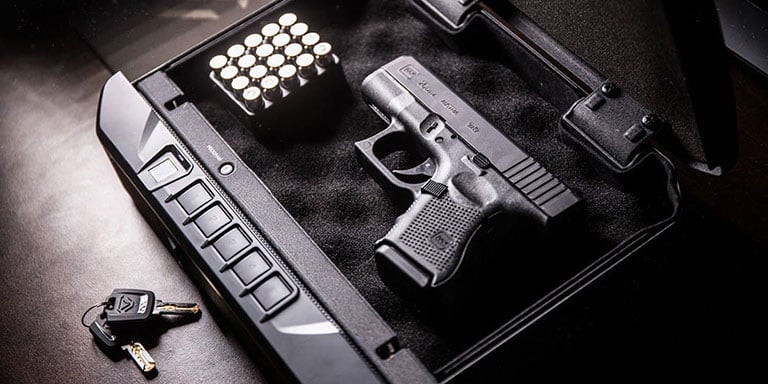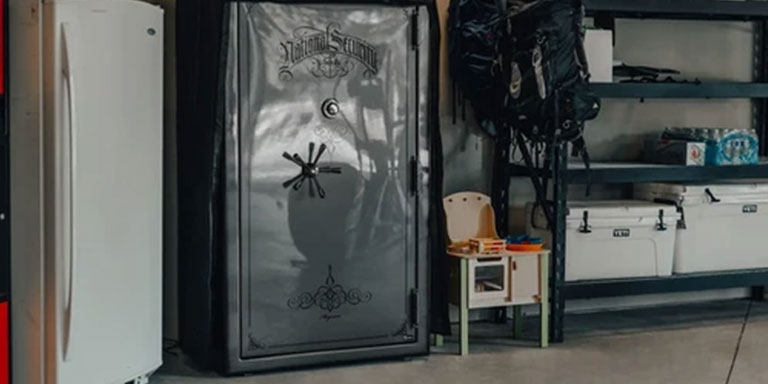Protecting Your Guns: A Complete Guide to Gun Safes


Buying a gun safe is a worthwhile investment, especially if you own multiple guns. However, there are many questions and caveats about choosing the right safe, such as what size to buy, where the safe should be placed in your home, how to secure the safe to the floor and more. Again.
In this guide, we aim to answer all of these questions to help you find the best gun safe in which to store your gun collection.
Discover our shooting equipment >>
Methods of Securing Guns at Home

There are many good reasons to secure guns at home. In fact, in most jurisdictions, the law requires it. It is also part of responsible gun ownership to keep guns out of the reach of children and protected from thieves. Deciding on the size, type and location of a gun safe will depend on the level of protection the gun owner wants and what they can afford.
Taken to extremes, a serious collector of rare firearms can build an entire room as a fortified safe complete with self-contained alarm and fire suppression systems. Most gun owners dream of having such a room with a hidden James Bond-style door concealing the entrance to the safe. Coming back to reality, the average gun owner needs to stick to their budget to secure and protect their firearms.
Two categories of gun owners
Most gun owners fall into one of two categories. In the first case, the gun owner has a single handgun for home protection .
The weapon is usually located in the master bedroom and secured in a small, quick-access safe. The primary purpose of these small metal safes is to protect them from the curious fingers of children. Most of them can be opened very quickly with a keyboard combination or a fingerprint reader. If there's an intruder in the house, seconds count.
On the negative side, these weapons are most likely to be located and stolen during a burglary when no one is home. Indeed, they are generally not very resistant to break-ins and the master bedroom is the first place where burglars look for jewelry, guns and other valuables.
The second category of gun owners includes a combination of handguns and sporting rifles. They too need quick access to a home defense firearm, but don't need immediate access to their entire arsenal.
The best solution for them may be a combination of quick-access handgun vaults and a larger safe permanently attached to the floor as a significant barrier against burglars.
The self-defense handgun safe

Self-defense handgun safes tend to be small, easy to open quickly, and are often concealed or hidden from view. They tend to be located in one or more places where the owner expects an immediate need.
The most common place is in the master bedroom to protect against a nighttime intruder. The second is a common space near the front door to protect against a home invasion or a daytime intruder.
These small safes are highly concealable and many are portable. In a common area, they can be secured in a cabinet drawer. Some furniture makers develop unique compartments for hiding handguns, such as inside coats or behind mirrors.
In the master bedroom, standard locations for a handgun include the bottom drawer of a nightstand or under the bed. Hiding places can also be integrated into a piece of furniture or a shelving system. The owner can quickly access the weapon; however, there is little security against theft other than the skill of concealment.
A small combat pouch should accompany a self-defense firearm inside the safe. In the pouch there should be a flashlight, an extra charger and handcuffs or zip ties. The bag may also include a less lethal option, such as pepper spray or a taser (but only if legally possessed in the owner's jurisdiction).
Large safes and vaults

While a small, easily accessible handgun safe may be necessary, the owner of multiple guns will also need a large safe or gun safe. These are usually tall, heavy units that can hold multiple handguns, a range of long guns, and lots of ammo.
They provide additional security against loss through theft, as well as some protection against fire and water damage.
Firearms (especially handguns) are one of the most prized items for burglars. Thieves tend to close many stolen items for a fraction of their value; however, handguns are the exception, often selling well above retail value. If a thief can't open a safe, he may try to get away with it in order to break into it later by force.
As a result, large vaults must be secured to make them immovable. Gun vaults can be securely bolted to floors and walls. Almost all safes have pre-drilled holes and instructions for proper installation. Anyone who is not particularly comfortable with power tools may want to have their safe installed by a professional.
Size is an essential consideration in buying a large gun safe. Consider how many guns you currently own and how many guns you are likely to buy in the future . It's never good to run out of space in the gun safe, so bigger is better.
Fastening to wood floors

The next consideration when choosing a gun safe is the weight of the safe. Many larger safes can weigh up to or exceed a thousand pounds. This can put a strain on the floor joists.
The strongest area of a floor (in conventionally built homes) is the area closest to an exterior wall - this is where the exterior wall plate and floor joists meet. Floor joists and wall studs should be located using a stud finder.
The safe should be secured to multiple wall studs and floor joists with screws or bolts recommended by (or in many cases supplied by) the safe's manufacturer.
A second floor installation can be a little tricky depending on the weight of the safe. The strongest points on upper floors are against an exterior wall, preferably directly above a load-bearing wall on the first floor.
If you are unsure, err on the side of caution and speak to a building contractor or safe installer regarding proper placement of a heavy duty safe.
Fastening to concrete floors

Arches can also be fixed to concrete floors. These usually involve either an attached garage or a basement. Special expansion bolts can be used and epoxy in place, providing superior holding strength.
A word of caution about securing an arch to concrete: some concrete floors are designed with cables running through them under tension. Hitting one of these cables while drilling can damage the integrity of the floor. These floors usually have warnings stamped into the concrete advising not to drill.
Garage Safes
A safe located in a garage should not be visible to passers-by, even when the garage door is open. It may be a good idea to build a cabinet around the safe with cabinet doors to conceal it.
Locating a gun safe in the garage can allow a criminal with a truck to use the power of the vehicle to free the safe from its bolts. Additionally, even a large, heavy safe can be knocked over and forced into the bed of a pickup truck.
The basement safe
A vault located in the basement presents unique challenges. First of all, it can be difficult to fit such a large and heavy object into space. Some safes are not waterproof and a basement can be flooded by a severe weather event or a plumbing failure.
An additional consideration is the humidity of the space. A damp or moldy basement can cause guns to rust. If you're considering installing a basement safe, look for one that's specifically guaranteed to be waterproof.
Fire protection
Another consideration for any safe is its ability to protect the contents from fire. Many safes have fire resistance ratings. Generally, the higher the temperature rating and the longer the protection time, the higher the price. These protection standards are indicated in degrees and minutes.
An example would be a safe designed to withstand 1,500 degrees for forty-five minutes. A collection of high value firearms should be photographed, cataloged and insured separately.
Never advertise
It's always best for as few people as possible to know that a residence contains firearms. It can be really cool to have a hidden gun compartment in a shelf or cabinet, but it only works if it's kept secret.
These places should not be revealed to impress your friends or neighbors; information has a way of being transmitted innocently until it ends up reaching the wrong ears. The only people who should know how a gun owner secures or conceals their firearms are members of the household authorized to use them.
Oddly enough, there are a plethora of novelty signs that people buy and post outside regarding gun ownership.
Most of these signs are meant to be humorous, such as the pointed handgun sign that reads "WARNING: Anyone found here at night will be found here in the morning."
These signs convey a message to a criminal: here is a house that contains firearms. This may seem like a powerful deterrent, but to a thief it's an inducement that guns are there for the taking.
Anyone who owns firearms should also own a way to secure them. Firearms are deadly weapons and should never fall into the hands of children.
A gun safe is an essential part of responsible gun ownership. They come in all shapes and sizes, and at prices to suit all budgets.
If you currently keep unsecured firearms, purchase a safe, install it properly, and become a responsible gun owner.
0 comments